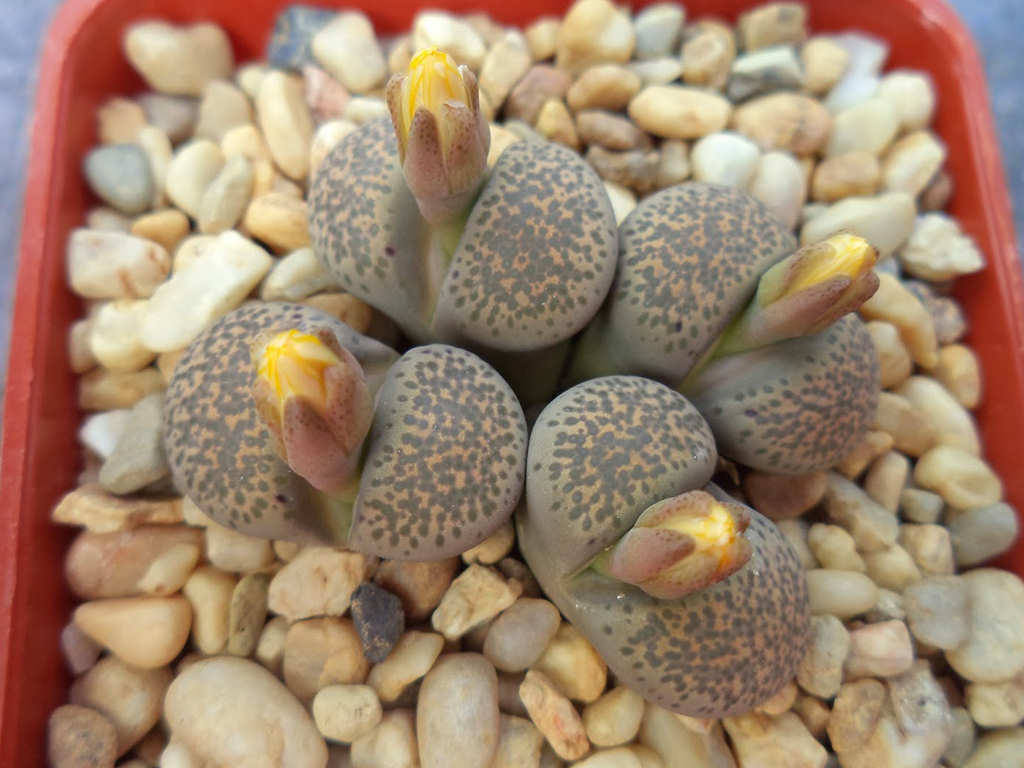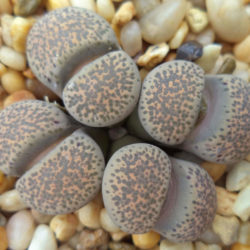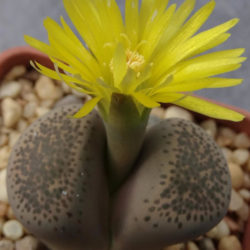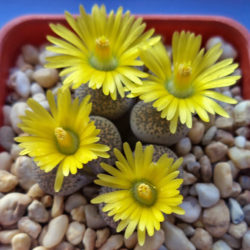Scientific Name
Lithops localis (N.E.Br.) Schwantes
Common Name(s)
Local Living Stone
Synonym(s)
Lithops localis, Lithops localis var. peersii, Lithops localis var. terricolor, Lithops peersii, Lithops terricolor, Mesembryanthemum locale
Scientific Classification
Family: Aizoaceae
Subfamily: Ruschioideae
Tribe: Ruschieae
Genus: Lithops
Origin
This species is native to South Africa. It mainly occurs in the southern Karoo region, growing under small shrubs and stones on gravel plains and sand flats.
Description
Lithops localis, also known as Lithops terricolor, is a dwarf stemless succulent with a pair of brownish-grey to pale green leaves fused in a body more or less kidney-shaped from above. It grows solitary or usually in clumps of 6 to 10 plants. The bodies are up to 1.4 inches (3.5 cm) tall. Leaves are parted by a fairly deep fissure. The upper surface of the leaves is smooth, usually slightly convex, and densely covered with dusky dots on an earth-colored background. It is up to 1.2 inches (3 cm) long and 1 inch (2.5 cm) wide. Flowers are yellow, sometimes with a white center, rarely pure white, and appear in the summer of fall. They are up to 1.2 inches (3 cm) in diameter. Fruits are mostly 5-locular capsules.
Etymology
The specific epithet "localis (lo-KAL-iss)" is a Latin adjective meaning "belong to a place" or "local."

How to Grow and Care for Lithops localis
Light: A sunny windowsill where the plant receives 4 to 5 hours of direct sunlight during the early part of the day and partial shade during the afternoon is the perfect spot to grow your L. localis. You may place the pot on the balcony or in the garden from spring to fall.
Soil: L. localis thrives best in a growing medium that will drain quickly. Use a commercial soil mix for succulents or make your own potting mix.
Hardiness: High temperatures are not a problem for this plant as long as there is plenty of fresh air, but it is not a cold-hardy succulent. L. localis can withstand temperatures as low as 30 to 50 °F (-1.1 to 10 °C), USDA hardiness zones 10a to 11b.
Watering: Like all Lithops, this succulent has a specific yearly cycle of growth, and it is important to water only during certain stages, but it is also important to keep the soil dry at other stages of its growth. How often you need to water your L. localis depends on how quickly the potting mix dries out. It is essential to let the soil dry out between waterings. Stop watering during the winter months to allow the old leaf pair to dry out and the new pair to develop.
Fertilizing: L. localis does not need to be fertilized. It will thrive without any feeding. If you decide to feed, use a fertilizer with high potassium and low nitrogen levels.
Repotting: This small succulent will happily stay in the same pot for several decades. The common reason for repotting is to divide the plant or to allow space for clusters to grow. Repot only when its growing season starts.
Propagation: L. localis is most often grown from seeds. If you have a multi-headed plant, it can also be propagated by division. Sow the seeds during the summer.
Learn more at How to Grow and Care for Lithops.
Toxicity of Lithops localis
L. localis is non-toxic and safe to have around children and pets.
Links
- Back to genus Lithops
- Succupedia: Browse succulents by Scientific Name, Common Name, Genus, Family, USDA Hardiness Zone, Origin, or cacti by Genus
Photo Gallery
Click on a photo to see a larger version.


